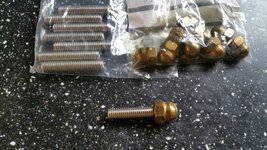It's a 1200 Hexhead!
Same answer. Do it proper. (Thought it was only the 1100s that had 4 studs. Every day is a school day.
 )
)It's a 1200 Hexhead!
 )
)Same answer. Do it proper. (Thought it was only the 1100s that had 4 studs. Every day is a school day.)
Has anyone here experimented with Titanium studs.
Non corrosive
Heat resistant.
Tensile strength higher than stainless steel
Not too expensive for just 4 studs.


Not quite what the OP asked but entirely relevant to the subsequent repair.
This NASA research article will tell you all about nuts bolts washers and studs; the pros and cons of each type of material, adhesives such as loctite etc
Make yourself a cuppa and take a seat ....,
LINKY
Courtesy of Tony on the ‘Guzziriders’ forum. Here’s a screenshot of the contents.

Don't drill too deep. You'll soon find out if you do


Stainless studs are not always a good option. Electrolytic corrosion will have caused the original problem. It’s going to be a whole lot worse with stainless studs. The metal also creeps at high temperature so the clamping force weakens and nuts go loose.
Just fit the original spec but don’t leave them so long before checking for corrosion.
Stainless nuts will also increase the rate of zinc loss on galvanised fasteners. In the old days brass nuts were used.
I reckon a stainless stud with a brass nut is the answer... In fact i had two nuts on my 1150 that had sheered off and i thought that when i get around to sorting them i would remove all the studs. So i bought a load of ss studs and load of brass cap nuts. Still in the drawer!
The thinking is, that the stainless stud will do as you say, become a part of the head. But with a brass nut, it will actually provide a really sound, non-corroding fixing that you can always undo.
Waisted section plain steel, I used domed stainless nuts after the 'usual' problems with the 11r.Good thinking. I've found some brass closed nuts nearly identical to the o/e ones, although I suspect the o/e are chrome over steel. Do you recall whether the o/e studs are plain or waisted? If waisted is the plain section in the middle?

I agree. The stainless cap nuts in most cases will do the job. I just had a chance to over think the problemI've got boxes of stainless steel cap nuts identical to the original fittings. Never had any problems using them on the original studs, used to supply them in my stainless kits, never heard of any problems with anyone else using them and I must have sold hundreds over the years.

This gets my vote, i service and repair Bmw' s all the time and in fact i have an 1150gs in now with all four snapped at well as both spark plugs! The nut welded on is by far the best way but you must get the stud molten in the nut for a good weld, then a quick burst of nitrogen on the head near the threads and either an air gun or electric nut gun whizzes them straight out.Get a nut that just fits over stud and mig weld stud/nut. Heat can help break corrosion and allows a fitted socket to remove stud.
Sent from my SM-N910F using Tapatalk

